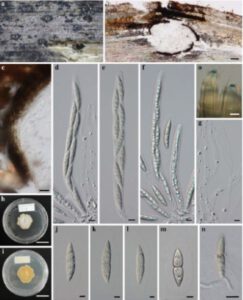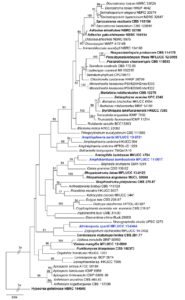Amphibambusa bambusicola D.Q. Dai & K.D. Hyde
Index Fungorum number: IF550941, Facesoffungi number: FoF00448, Fig. 1
Etymology – In reference to the host Bambusa and cola meaning loving.
Holotype – MFLU 14–0825
Saprobic on decaying bamboo culms, forming a black circular spot on host surface. Sexual morph: Ascomata 500– 800μm diam., 450–700μm high, solitary, scattered, immersed under the host epidermis, globose to subglobose, light brown, coriaceous, ostiole at the centre, surrounded by a small blackened clypeus and ostiolar opening surrounded by white margin. Peridium laterally 20–30μm thick, composed of thick-walled, brown to hyaline cells of textura angularis. Hamathecium composed of long, septate, paraphyses, 6–7 μm wide at the base, 2.5–3 μm wide at the apex, with hyaline, guttulate cells. Asci 150–200×17.5–20μm (x=180.6× 19.1μm, n=20), 8-spored, unitunicate, cylindrical, short pedicellate, with a cylindrical, J+, subapical ring, 1.5–3μm high, 2–3.5μm diam. Ascospores 25–27×5.5–6μm (x=26.6× 5.7μm, n=20), 2-seriate, fusiform to broad-fusiform, 1-septate, deeply constricted at the septum, hyaline, pointed at both
ends, with a longitudinally striated wall and surrounded by 10μm thick, gelatinous sheath. thick, gelatinous sheath. Asexual morph: Undetermined.
Culture characters – Ascospores germinating on PDA within 36 h and germ tubes produced from upper cells. Colonies growing slowly on PDA, reaching 5 mm in 2 weeks at 28 °C, effuse, velvety to hairy, circular, irregular at the margin, white from above, yellowish from below. Mycelium immersed in the media, composed of branched, septate, smooth-walled, hyaline, hyphae.
Material examined – Thailand, Chiang Rai, Jiew Santonkok, on dead culm of bamboo, 11 August 2011, Dong-Qin Dai DDQ00104 (MFLU 14–0825, holotype), (isotype in KUN, under the code HKAS 83940); ex-type living culture, MFLUCC 11–0617, IMCP.
GenBank numbers – ITS: KP744433; LSU: KP744474.
Notes – Kang et al. (1999a, b) included ten sexual genera and their pestalotia-like asexual morphs in Amphisphaeriaceae (sensu lato). Amphibambusa is clearly different from other genera of Amphisphaeriaceae based on molecular data and morphological characters. This monotypic genus is introduced to accommodate taxa characterized by immersed ascomata surrounded by a small blackened clypeus and ostiolar opening surrounded by a white margin, and cylindrical asci with fusiform ascospores surrounded by wide gelatinous sheath. Amphibambusa bambusicola is similar to Amphisphaeria coronata in having immersed, black ascomata, cylindrical asci and fusiform ascospores (Saccardo 1925). However, Amphibambusa bambusicola is distinct in having wider asci (17.5–20 μm wide versus 7–8μm) (Saccardo 1913). Our new taxon can also be compared with Amphisphaeria bambusae which has ellipsoid, 14–17 × 8–9 μm spores, while the spores in Amphibambusa bambusicola are fusiform, 25–27 × 5.5–6 μm.

Fig. 1 Amphibambusa bambusicola (holotype) a Ascomata immersed in bamboo host. b Section of ascoma. c Peridium of ascoma. d–f Asci. g Paraphyses. j–m Ascospores surrounded by a wide gelatinous sheath. n Germinating ascospore. h, i Culture on PDA. o J+, subapical ring staining by Melzer’s reagent. Scale bars: a=100 mm, b=100μm, c–g=10μm, h, i=25 mm, j–o=5μm.

Fig. 2 Phylogram generated from Maximum Likelihood analysis based on LSU gene region of Amphisphaeraceae and related taxa in Xylariales. Maximum likelihood bootstrap support values greater than 50 % are indicated above or below the nodes. The ex-types (reference strains) are in bold; the new isolates are in blue. The tree is rooted with Hypocrea gelatinosa NBRC 104900.
